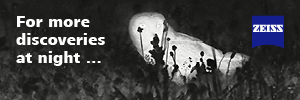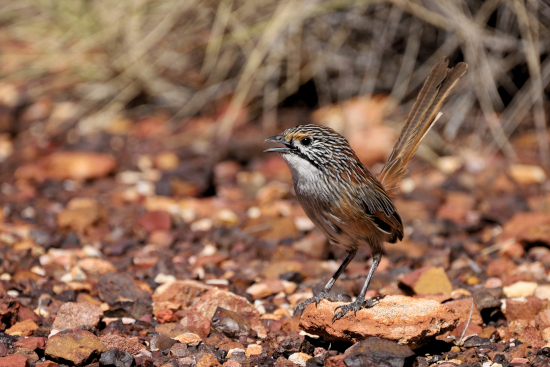(Added first image) |
(→External Links: new combined GSearch. GSearch Checked Template. No Gallery images note) |
||
| Line 39: | Line 39: | ||
{{ref}} | {{ref}} | ||
==External Links== | ==External Links== | ||
| − | {{GSearch|Amytornis | + | {{GSearch|"Amytornis rowleyi! {{!}} "Opalton Grasswren"}} |
| + | <!--No images at time of last edit 17 Apr 2024)--> | ||
| + | {{GS-checked}}1 | ||
| + | <br /> | ||
| + | <br /> | ||
[[Category:Birds]] [[Category:Amytornis]] [[Category: Missing Images]] | [[Category:Birds]] [[Category:Amytornis]] [[Category: Missing Images]] | ||
Revision as of 07:43, 17 April 2024
Alternative name: Rusty Grasswren
- Amytornis rowleyi
Identification
14 cm
- Upperparts deep rufous-brown with white streaks
- Underparts deep buff with heavy white streaking on the pale cream breast and belly
- Rufous eyebrow
- Black whisker-streak
- White throat.
- Blackish-brown tail (shorter than other Grasswrens)
- Black bill
- Bluish-grey legs
Female has pale chestnut flanks
Immature individuals are slightly duller
Distribution
Endemic to Forsyth Range (central Queensland), Australia.
Taxonomy
This is a monotypic species.
Formerly included in Striated Grasswren.
Habitat
In spinifex on rocky ranges.
Behaviour
Skilled at hiding and keep growth between themselves and any observer, so the chance of finding is remote. Occasionally in spring breeding will be sighted while singing.
Breeding
The female builds a domed nest out of dry grasses and bark, lined with fur, soft vegetation or feathers. The 2-3 eggs are incubated for two weeks; the young leave the nest two weeks later.
Diet
The diet includes seeds, insects and spiders.
Vocalisation
High, scratchy trills, "chweep, chweep" for contact and "tsee, tsee". In alarm, "tzirr". Also musical notes "tsee-tsee, piew-piew"
References
- Clements, J. F., T. S. Schulenberg, M. J. Iliff, S. M. Billerman, T. A. Fredericks, J. A. Gerbracht, D. Lepage, B. L. Sullivan, and C. L. Wood. 2021. The eBird/Clements checklist of Birds of the World: v2021. Downloaded from https://www.birds.cornell.edu/clementschecklist/download/
- Avibase
- BirdLife International.
- Field Guide to Australian Birds - Michael Morcombe
- nsw.gov.au
- Birdforum thread discussing taxonomy of Grasswrens
Recommended Citation
- BirdForum Opus contributors. (2024) Opalton Grasswren. In: BirdForum, the forum for wild birds and birding. Retrieved 1 May 2024 from https://www.birdforum.net/opus/Opalton_Grasswren
External Links
GSearch checked for 2020 platform.1




